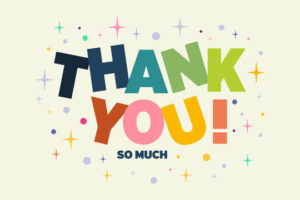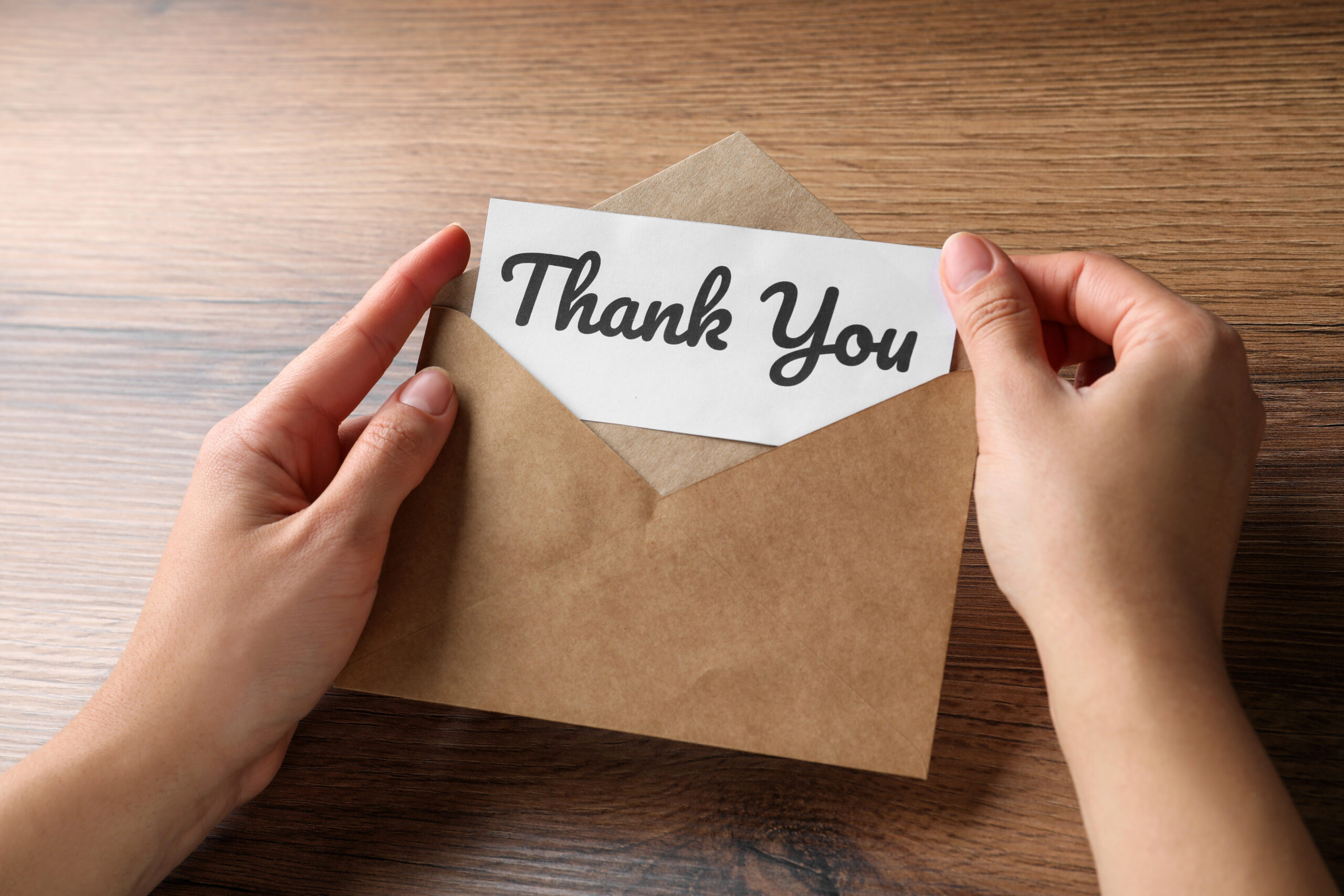As some of your biggest annual revenue generators, events are a big deal. Between planning and hosting, these events take up a lot of your team’s time and energy. Ensure you end fundraisers on a high note by perfecting your post-event thank-you strategy.
After having a great time at one of your events, guests who receive a message thanking them for their attendance are more likely to remember your nonprofit, think well of your organization, attend upcoming events, and of course, donate in the future.
But what should these thank you messages look like? To help your nonprofit craft post-event messages that will retain donors, improve brand recognition, and earn continued support, we’ll walk through how to create impactful thank yous for four different outreach methods. Let’s get started.
1. Mailed Letters
Physical mail is slow but it still has its place in many nonprofits’ appreciation strategy and for good reason. In the digital age, slowing down and sending a physical thank-you card can feel extra meaningful.
Begin creating your donor thank-you letters by designing a message template. For event guests, you might adjust a template you already have, like your donation thank-you message, or you can hunt around online to find a free template for events that you like.
Then, adjust your template to fit your nonprofit’s unique voice and add details about your specific organization and event. For example, you might include information about what the event raised money for or details about how your nonprofit hosts the event every year.
Finally, consider how you’ll personalize your letters by adding information unique to each supporter. This includes their name, their history with your nonprofit, whether they donated at your event, and more. Ensure the information you intend to reference is stored in your CRM and that your messaging tools can easily pull the right data.
Be aware that mailed letters are likely to exceed the 48-hour deadline for thanking supporters. As such, consider supplementing physical letters with emailed thank-you messages or eCards you can send off quickly while waiting for your letters to arrive.
2. Gifts
Fundraising galas and auctions are essentially big parties where supporters are invited to have fun, connect with others in your community, and celebrate your nonprofit. Like with parties you attend in your day-to-day life, send your supporters home with a little something to remember the fun time they had thanks to your organization.
Thank you gifts can be small presents either given to supporters at the end of an event or mailed out after the fact. Planning to wait until later to mail gifts can be the right call if you have concerns about passing out presents to every guest at your event, especially when they may be in a rush to get home.
Either way, a few gift ideas include:
- T-shirts and other apparel. Branded t-shirts, hats, and other apparel are effective thank-you presents your supporters will want to use long after your event. Whenever they wear your apparel, they’ll be reminded of your nonprofit and the fun they had at your event while also promoting your organization to anyone who sees their new clothing.
- Goodie bags. Rather than giving out a single item as thanks, put together party goodie bags that contain multiple little presents. For instance, these might include candy, a branded pen, a thank-you card, and a laminated fact sheet about your cause. For nonprofits on a budget, handing out small but decorated goodie bags is an easy way to appreciate donors without worrying about mailing and merchandising costs.
- Branded merchandise. The world of nonprofit merchandise extends far beyond apparel. Thank guests with branded keychains, fridge magnets, stickers, wristbands, mugs, water bottles, tote bags, bumpersticks, and more. The more creative you get with your merchandise, the more likely supporters are to remember your nonprofit and sign up for your next event.
When designing merchandise, consider making your thank-you presents specific to your event. If you have an annual fundraiser where you hand out branded t-shirts with the date on them every year, you might pick up a loyal group of supporters who look forward to collecting their new shirt each year.
3. Phone Calls
Thank you messages should be personal, and it’s harder to get more personal than directly talking to your supporters one-on-one. Aside from your major donors, arranging individual meetings with each of your guests is far from practical, but calling them on the phone is definitely feasible.
After your event, host a thank-you call-a-thon. Write a brief script for the calls, gather volunteers and staff members, have snacks ready, and get to calling. For your volunteers, your event team may be willing to volunteer again or consider reaching out to your board to help with calls. Getting a personal call from a member of your board is likely to make supporters feel appreciated and like an important member of your community.
If you don’t have your guests’ phone numbers, consider performing a phone number append. Double the Donation defines phone number appending as “the process of inputting supporter data into phone append software and receiving missing and updated phone numbers back.” Essentially, you just need to get in touch with a phone number appending service that will use their software and access to third-party datasets to identify your supporters and pair them with their phone numbers.
From there, just set the time aside to schedule your phone calls. If you decide to use this thank-you method, consider also expressing gratitude using another channel, such as email or traditional mail, to make sure any guests who don’t pick up still receive the appreciation they deserve.
4. eCards
The key to an appreciation message that boosts donor retention is a meaningful, memorable thank you that is delivered quickly. Nonprofits should thank supporters within 48 hours of a donation, and the same timeline applies to your events. The faster you reach out to show appreciation, the fresher the event will be in your supporters’ memories, leading to a more impactful thank you.
However, emailed thank yous often aren’t memorable, and traditionally mailed cards are far from speedy. Fortunately, there’s one communication method that takes the best of both worlds without the drawbacks of either: eCards.
eCardWidget explains that eCards are digital versions of greeting cards delivered electronically. For nonprofits, eCards are a fast, cost-effective way of reaching out to attendees post-event to show appreciation.

To create an eCard your guests will hold on to long-term, design your eCards with these elements in mind:
- Eye-catching visuals. eCards are all about visuals. Use your eCard provider’s templates to jumpstart the design process or upload image assets to ensure your cards reflect your unique organization. Some nonprofits even take advantage of the electronic format by including animations in their eCards.
- Short, meaningful message. Pair your striking visuals with a short but earnest message thanking guests for attending your event. Consider personalizing messages by mentioning past gifts supporters have made or previous events they attended. Sign off your cards as coming from your entire nonprofit team or a specific high-level member of your staff, like your executive director or board director.
- Fast delivery. Speed is one of eCards’ greatest strengths. Design your eCards far in advance, then set a delivery date for your cards to get sent out. This way, you can reduce your team’s post-event responsibilities, allowing them to enjoy the rewards of their hard work after double-checking that the eCards were sent out at the right time.
Ultimately, your eCards’ design will depend at least in part on your eCard provider. Hunt around to find a platform with easy-to-use design tools and the ability to customize your eCards to your exact needs. Plus, if you end up liking the platform you used for your event follow-up, you can use it to make eCards for future events and fundraisers.
Whether your event was easy to put together or has taken the better part of a year to plan, your follow-up process is essential for securing long-term support. Make deciding how you’ll thank guests after your event a part of your planning process and be ready far ahead of the event itself, whether you intend to send eCards, make phone calls, or mail out letters.


